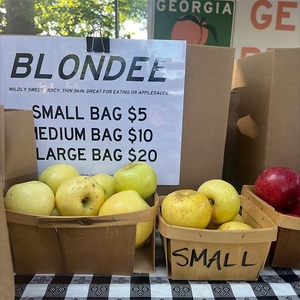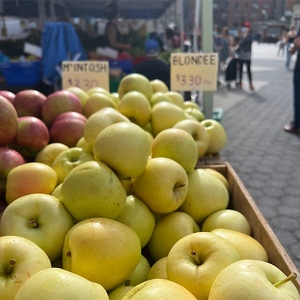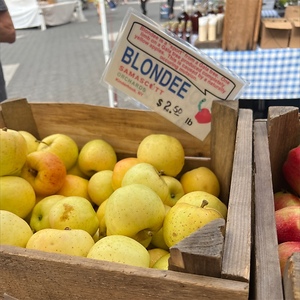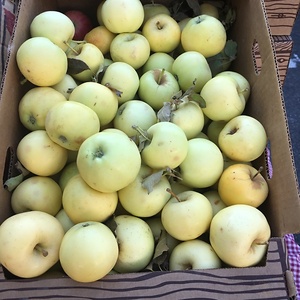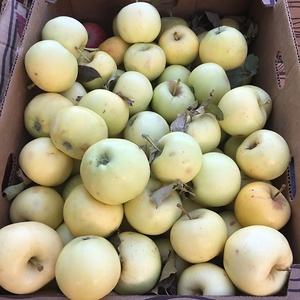

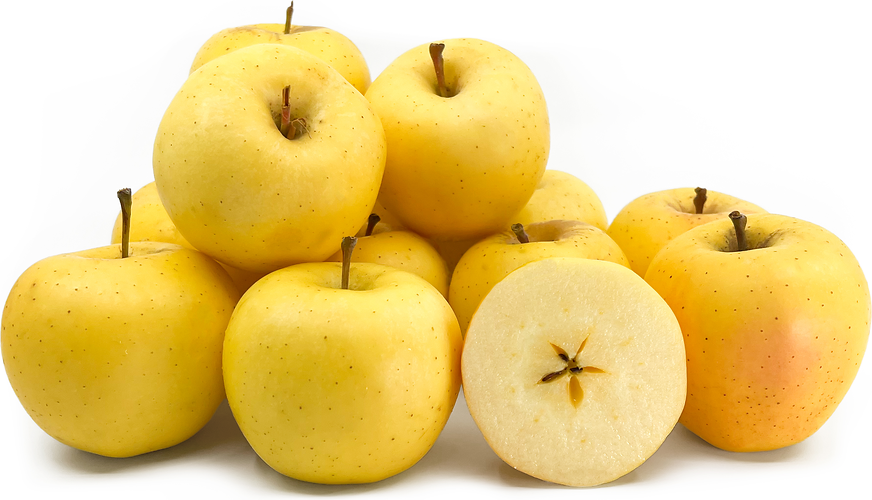
Blondee® Apples
Estimated Inventory, lb : 0
Description/Taste
Blondee® apples are a medium to large varietal, averaging 7 to 8 centimeters in diameter, and have a uniform, round, to conical shape with some ribbing and a tapered base. The apple’s skin is smooth with patches of textured russet surrounding the stem and is speckled with a few tan lenticels. The surface also has a pale-yellow appearance, occasionally tinged with green or a slight red-orange blush, depending on sun exposure. Underneath the thin skin, the white to yellow flesh is firm, coarse, and aqueous with a crisp and crunchy consistency. The flesh is also slow to brown and resistant to bruising, encasing a small central core with tiny, black-brown seeds. Blondee® apples have a mild and sweet flavor with slight acidity, nuanced with faint notes of honey, melon, and spices.
Seasons/Availability
Blondee® apples are available in the late summer through early fall.
Current Facts
Blondee® apples, botanically classified as Malus domestica, are an early-season variety belonging to the Rosaceae family. The yellow apples were discovered growing as a sport of a gala apple in an orchard in Ohio in the early 21st century and were selected for their unusual coloring, crisp texture, and sweet, mild flavor. Blondee® apples grow on trees that can reach over four meters in height and are a consistent, productive variety that can produce over 800 bushels per acre. The apples are also one of the only yellow apple varieties to appear early in the season and are sometimes nicknamed Yellow Galas. Blondee® apples are primarily consumed fresh, but some apple enthusiasts also incorporate the variety into desserts, sauces, and baked goods.
Nutritional Value
Blondee® apples are a source of vitamin C to strengthen the immune system, potassium to balance fluid levels within the body, and fiber to regulate the digestive tract. The apples also provide vitamin E to protect the cells against free radical damage, vitamin A to maintain healthy organ functioning, calcium and phosphorus to build strong bones and teeth, and other amounts of boron, magnesium, zinc, copper, and iron.
Applications
Blondee® apples have a sweet flavor well suited for fresh and cooked preparations. The apple’s thin skin contributes to a crisp, tender nature when consumed fresh, out of hand, and the flesh oxidizes slowly, often incorporated into salads. Blondee® apples can also be chopped into fruit and grain bowls, shredded into slaws, sliced and layered into sandwiches, or sliced and displayed on appetizer platters with soft cheeses, other fruits, and nuts. The early-season apples can be used in any recipe calling for gala apples and can be pressed into juices or blended into smoothies. In addition to fresh preparations, Blondee® apples retain their shape when baked, combined into pies, tarts, cobblers, crisps, and turnovers. The apples can also be simmered into applesauce with other tart apples and served as a side dish to roasted meats, cooked into jams and jellies, baked whole as a dessert, or pureed and used as a filling in pastries, muffins, bread, and doughnuts. Blondee® apples pair well with nuts such as pecans, walnuts, pistachios, and almonds, dried fruits including cranberries, figs, dates, and raisins, vanilla, caramel, chocolate, and spices such as cinnamon, cloves, nutmeg, ginger, and allspice. Whole, unwashed Blondee® apples will keep 3 to 6 months when stored in a cool, dry, and dark place such as the refrigerator’s crisper drawer. In professional cold storage, the apples can be kept for up to ten months.
Ethnic/Cultural Info
Blondee® apples have had their greatest success among u-pick orchards throughout the “Apple Belt” of Michigan. Also known as Michigan’s “Fruit Belt,” the region is comprised of a narrow stretch of land along the western state border that has a temperate climate due to Lake Michigan moderating weather extremes. The Fruit Belt also receives enough rainfall to maintain the region’s fertile soil composition, and over time, the state has developed this area into a site for agrotourism, where visitors can tour farms, purchase fruit, and participate in food-themed events. The region was given this nickname in the late 1800s, and throughout the 1900s, several billboards were promoting the famous belt, and farm stands were established along the roadways to sell fruit to passing motorists. In the present day, Blondee® apples are grown in many of the orchards throughout the Fruit Belt, and the variety is favored for its long ripening period. Blondee® apples can remain on the tree for at least 2 to 3 weeks and are the only yellow variety to ripen during the early season, creating a pleasant visual contrast on the apple trees. Many of the u-pick orchards have commented that visitors select Blondee® apples for their unique appearance, and the apples have become the second most popular u-pick apple, just behind honeycrisp.
Geography/History
Blondee® apples were discovered as a spontaneous mutation of gala apples in an orchard in Portsmouth, Ohio. The sport apples were noticed by McLaughlin Orchard owners Tom and Bob McLaughlin sometime around the year 2000. The fruits were selected for their unusual coloring as they had a pale-yellow appearance, while their parent variety, the gala apple, was traditionally bright red. The McLaughlins applied for a plant patent in October of 2006 and was granted a patent in July of 2008 under USPP 19700. Blondee® apples were introduced into commercial markets in 2012 and the farm partnered with International Plant Management, or IPM, to license the variety to nurseries across the United States. IPM also established the catchphrase “delight at first bite” for the apple variety and began labeling the fruits with stickers showcasing the phrase. Today Blondee® apples are grown by select nurseries, and the apples are sold through farm stands, grocers, and distributors in North America.
Recipe Ideas
Recipes that include Blondee® Apples. One
| Candy Coated Culinista |
|
Apple Sauce |
| A Family Feast |
|
Apple Chunkies |
| The Mediterranean Dish |
|
Easy Apple Strudel with Phyllo |



